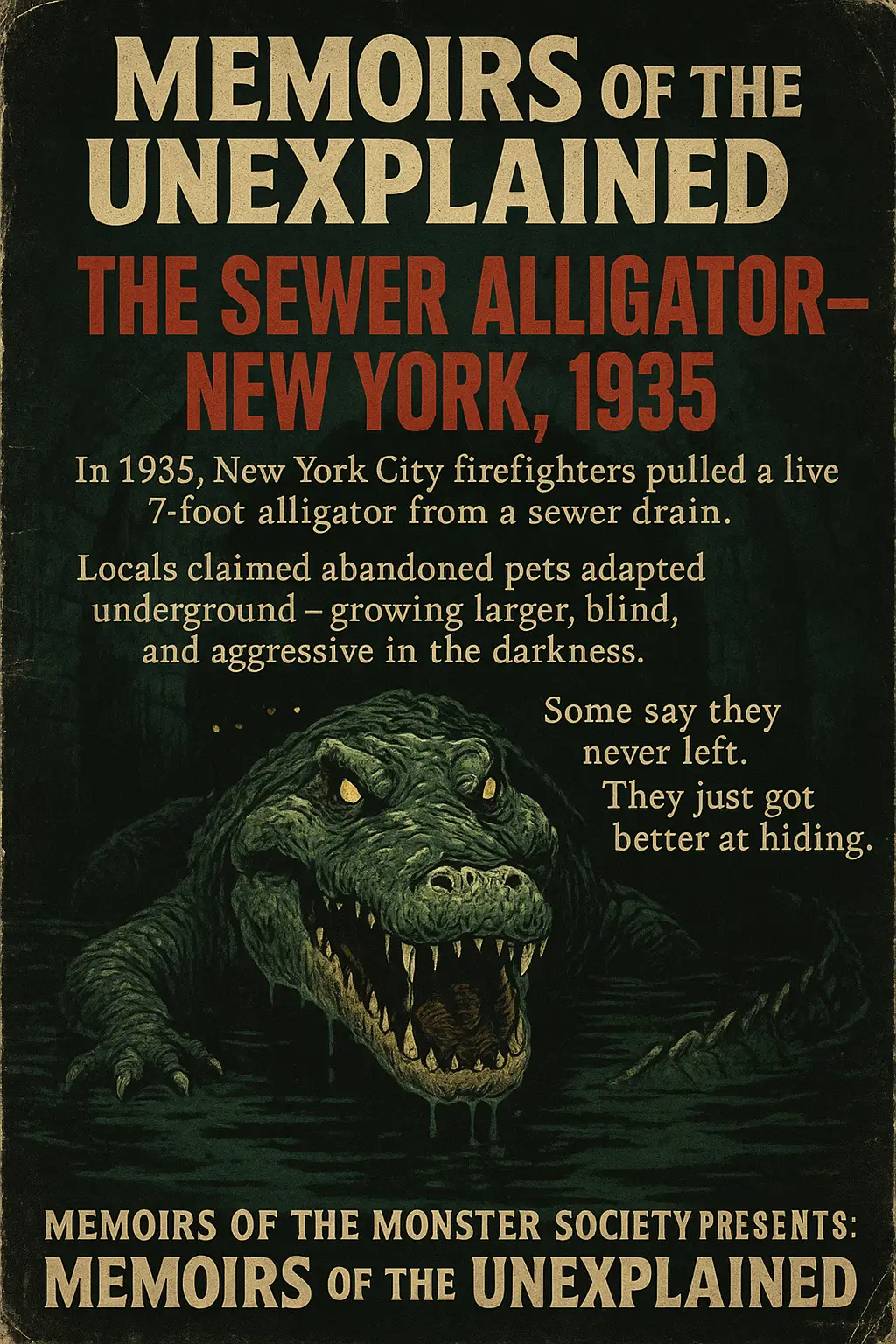
Memoirs of the Unexplained: The New York Sewer Alligator
Memoirs of the Unexplained: The New York Sewer Alligator
As members of the Monster Society, we gather around the flickering candlelight to share tales that blur the boundary between fact and fable. The New York sewer alligator is one such story, a legend that has slithered through the sewers and into the collective imagination for nearly a century.
On February 10, 1935, newspapers reported a startling scene in Harlem: while shoveling snow into a manhole, a group of boys glimpsed something thrashing below. In a feat of bravado, they fastened a slip knot, hauled the creature up and revealed a 7‑foot, 125‑pound alligator. With no photographs and official reports quickly incinerated, the monster vanished as quickly as it emerged. The episode, recounted in the New York Times and later repeated in Robert Daley’s The World Beneath the City, cemented the myth in popular memory.
The story resurfaced two decades later when Teddy May, the city’s superintendent of sewers, claimed he had seen colonies of alligators paddling serenely beneath Manhattan. His tale spoke of sewer safaris armed with rifles and rat poison and of nocturnal hunts through labyrinthine tunnels. Whether May intended a genuine warning or a whiskey‑fueled yarn, his account gave the legend a second life.
Today, the rumor persists. A search for ‘NYC sewers’ on Google still auto‑suggests ‘alligator,’ showing how embedded the legend is in urban consciousness. Artists have immortalized it in bronze sculptures, such as Tom Otterness’s Life Underground installation in the 14th Street subway station where a whimsical alligator snatches a man from a manhole. The cryptid even prowls through pop culture, appearing in Thomas Pynchon’s novel V. and inspiring trading cards and comics.
Skeptics point to the harsh realities of biology and climate. Reptile educators note that alligators cannot digest food when temperatures dip below 50°F; they would struggle to survive a New York City winter. Nests built from vegetation would be impossible in concrete sewers, and the reptiles couldn’t reproduce or thrive there. Yet cryptozoologists argue that alligators are ancient survivors, capable of enduring Ice Age cold. If they weathered glacial epochs, perhaps they could adapt to subterranean warmth and find sustenance in the abundant rats below.
The Monster Society’s memoirs of the unexplained focus on sharing each detail without dictating what to believe. We acknowledge that cryptozoology straddles the line between science and folklore. Critics call it a pseudo‑science that relies on anecdote, but supporters counter with examples of creatures—such as the okapi and Komodo dragon—once considered mythical but later proved real. Our role is not to dismiss the New York sewer alligator as mere urban legend or to claim indisputable proof. Instead, we gather reports, testimonies and historical sources and let readers make up their minds.
The Evidence Weighing Conspiracy and Reality
- Historical record: The 1935 Harlem incident stands as the most cited source. Boys pulled a diseased alligator from a manhole, an event documented by the New York Times. No official photos exist, and authorities incinerated the body, leaving ample room for speculation.
- Confessions of a sewer chief: Teddy May’s account of colonies of subterranean gators gave the myth substance. Critics argue he embellished, but his story inspired generations of hunters and explorers to peer into drains.
- Scientific skepticism: Reptile experts cite the species’ temperature sensitivity and reproductive needs, making long‑term survival unlikely. The absence of documented breeding populations supports this view.
- Cultural resonance: The myth thrives because it fits New York’s self‑image as a gritty, extraordinary place. The idea that fearsome creatures inhabit its sewers enhances the city’s mystique and fuels tourism, books and art installations.
How a Small Blog Can Use the Legend
- Long‑tail content: Create posts around specific angles like ‘Harlem alligator 1935’ or ‘cryptid NYC sightings.’ Low competition means your article can rank and appear in niche searches.
- Interactive media: Incorporate multimedia—maps of reported sightings, audio interviews with cryptozoologists and photos of Tom Otterness’s sculptures. Visuals increase dwell time and encourage sharing.
- Community engagement: Encourage readers to submit their own reports of urban legends. Host polls asking whether they believe in the sewer alligator. Audience participation reinforces the blog’s role as a hub for unexplained narratives.
- Link building: Cite credible sources like Untapped New York’s article and Winsby Inc.’s keyword research. Outbound links demonstrate research depth, while inbound links from forums and social media expand reach.
- Balancing belief: Maintain the Monster Society tone: we lean toward believing but acknowledge doubt. Avoid definitive statements; instead, pose questions and highlight conflicting evidence.
Final Thoughts
Legends endure because they invite us to ponder the unknown. The New York sewer alligator offers a microcosm of how folklore, news media and scientific inquiry collide. Whether you think of it as a cautionary tale about exotic pets or evidence of hidden beasts, the story fuels our curiosity and sense of wonder. As the Monster Society, we embrace both skepticism and belief. We will continue chronicling these memoirs of the unexplained, leaving the final verdict to our readers. After all, what fun would life be if there were no monsters hidden in the sewers below?
“””# Save HTML file html_file = Path(“/mnt/data/urban_alligator_blog.html”) html_file.write_text(blog_content)html_file.as_posix()